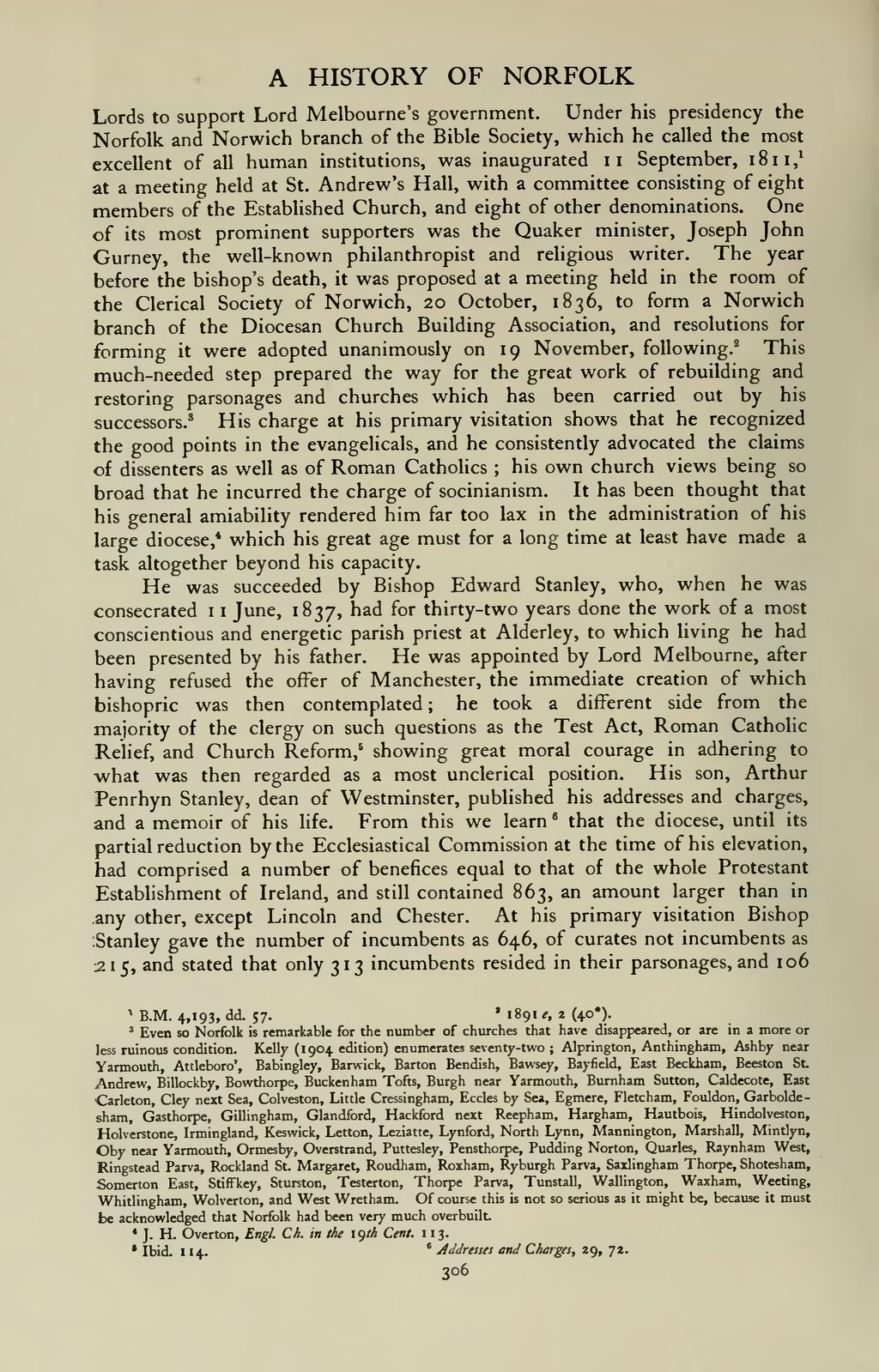A HISTORY OF NORFOLK Lords to support Lord Melbourne's government. Under his presidency the Norfolk and Norwich branch of the Bible Society, which he called the most excellent of all human institutions, was inaugurated ii September, i8ii,^ at a meeting held at St. Andrew's Hall, with a committee consisting of eight members of the Established Church, and eight of other denominations. One of its most prominent supporters was the Quaker minister, Joseph John Gurney, the well-known philanthropist and religious writer. The year before the bishop's death, it was proposed at a meeting held in the room of the Clerical Society of Norwich, 20 October, 1836, to form a Norwich branch of the Diocesan Church Building Association, and resolutions for forming it were adopted unanimously on 19 November, following.- This much-needed step prepared the way for the great work of rebuilding and restoring parsonages and churches which has been carried out by his successors.' His charge at his primary visitation shows that he recognized the good points in the evangelicals, and he consistently advocated the claims of dissenters as well as of Roman Catholics ; his own church views being so broad that he incurred the charge of socinianism. It has been thought that his general amiability rendered him far too lax in the administration of his large diocese,* which his great age must for a long time at least have made a task altogether beyond his capacity. He was succeeded by Bishop Edward Stanley, who, when he was consecrated 1 1 June, 1837, had for thirty-two years done the work of a most conscientious and energetic parish priest at Alderley, to which living he had been presented by his father. He was appointed by Lord Melbourne, after having refused the offer of Manchester, the immediate creation of which bishopric was then contemplated ; he took a different side from the majority of the clergy on such questions as the Test Act, Roman Catholic Relief, and Church Reform,^ showing great moral courage in adhering to what was then regarded as a most unclerical position. His son, Arthur Penrhyn Stanley, dean of Westminster, published his addresses and charges, and a memoir of his life. From this we learn ° that the diocese, until its partial reduction by the Ecclesiastical Commission at the time of his elevation, had comprised a number of benefices equal to that of the whole Protestant Establishment of Ireland, and still contained 863, an amount larger than in any other, except Lincoln and Chester. At his primary visitation Bishop
- Stanley gave the number of incumbents as 646, of curates not incumbents as
215, and stated that only 313 incumbents resided in their parsonages, and 106 ^ B.M. 4,193, dd. 57. ' 1891 e, 2 (40»). ' Even so Norfolk is remarkable for the number of churches that have disappeared, or are in a more or less ruinous condition. Kelly (1904 edition) enumerates seventy-two ; Alprington, Anthingham, Ashby near Yarmouth, Attleboro', Babingley, Barwick, Barton Bendish, Bawsey, Bayfield, East Beckham, Beeston St. Andrew, Billockby, Bowthorpe, Buckenham Tofts, Burgh near Yarmouth, Burnham Sutton, Caldecote, East •Carleton, Cley next Sea, Colveston, Little Cressingham, Eccles by Sea, Egmere, Fletcham, Fouldon, Garbolde- sham, Gasthorpe, Gillingham, Glandford, Hackford next Recpham, Hargham, Hautbois, Hindolveston, Holverstone, Irmingland, Keswick, Letton, Leziatte, Lynford, North Lynn, Mannington, Marshall, Mintlyn, Oby near Yarmouth, Ormesby, Overstrand, Puttesley, Pensthorpe, Pudding Norton, Quarles, Raynham West, Ringstead Parva, Rockland St. Margaret, Roudham, Roxham, Ryburgh Parva, Saxlingham Thorpe, Shotesham, Somerton East, Stiffkey, Sturston, Testerton, Thorpe Parva, Tunstall, Wallington, Waxham, Weeting, Whitlingham, Wolverton, and West Wretham. Of course this is not so serious as it might be, because it must be acknowledged that Norfolk had been very much overbuilt. • J. H. Overton, Engl. Ch. in the 19M Cent. 113.
- Ibid. 114. ' Addreae! and Charges, 29, 72.
306
